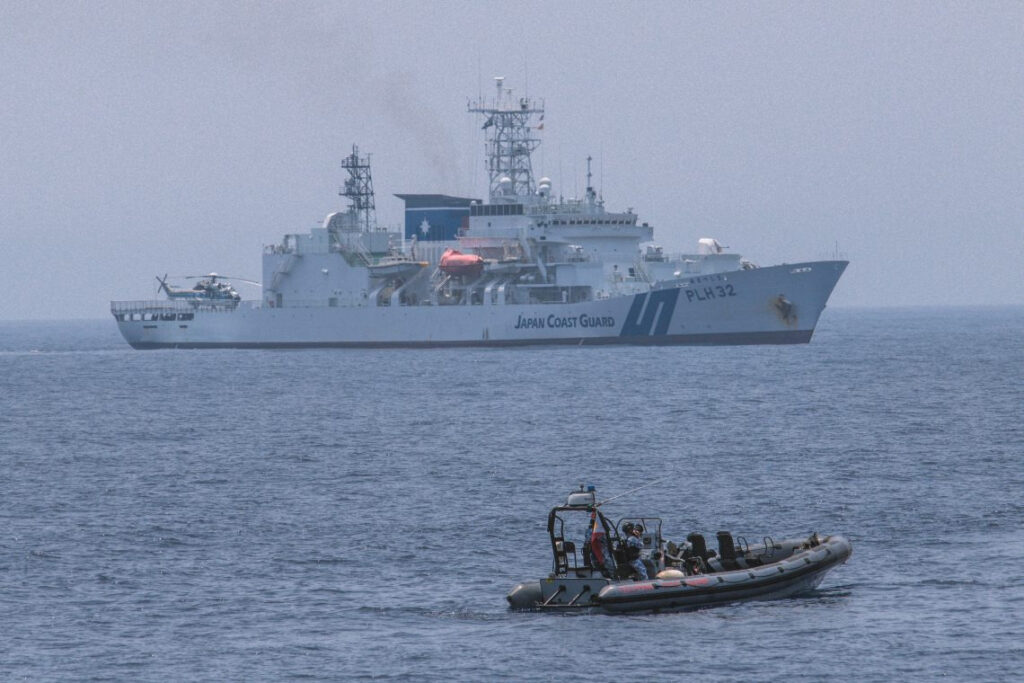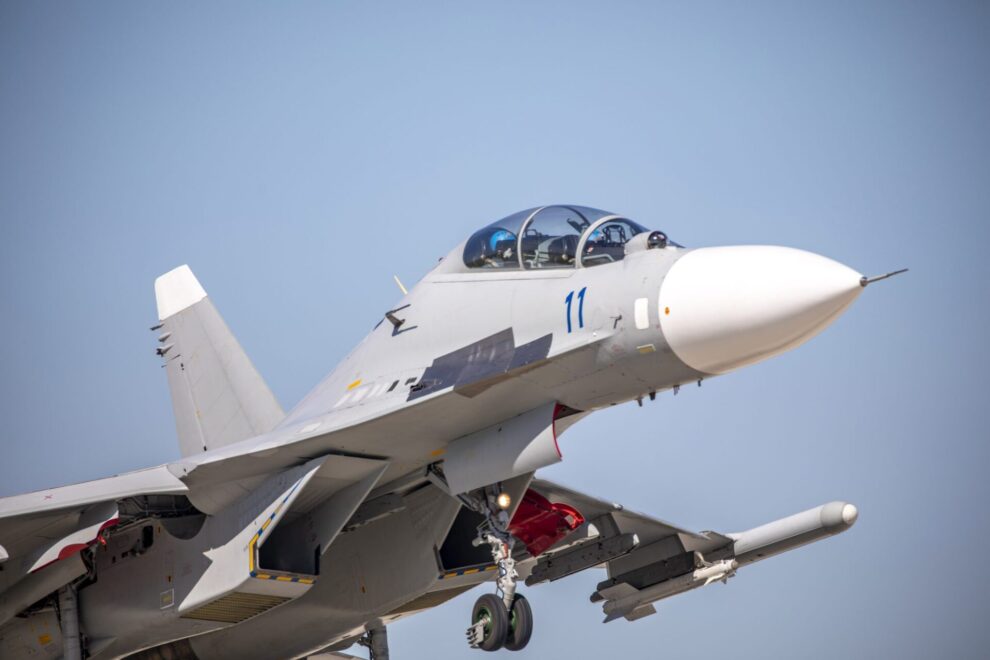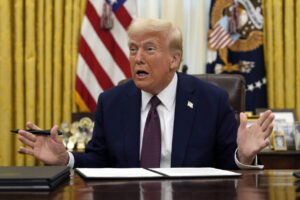While touting peace, Beijing’s moves to counter the U.S. in the Western Pacific have become increasingly confrontational.
Since China’s reform and opening up in the 1980s, the leaders of the Chinese Communist Party (CCP) have followed Deng Xiaoping’s policy of “hiding our capacities and keeping a low profile” while making full use of globalization to quietly stockpile Western technology and capital. In a little more than 40 years, China has come far. In economic terms alone, it has jumped to the position of global number two. But in the Xi Jinping era, the country has gradually edged into an open rivalry with the West, led by the U.S.
Until last year, the Xi-led CCP had seemed a bit shy about this new course, reluctant to let the word “competition” touch its lips. After the Biden administration adopted a stance of “frankness” on Sino-American relations, however, China has de facto acknowledged its deep engagement in this rivalry. This report reviews China’s competitive challenge to the U.S. from the perspective of diplomacy and geographic strategy.
The first clear language about the scale and the nature of this competition came from Washington. This was because the U.S. government was the first to realize that being so tolerant of China on the issue of technology transfer and technology theft would directly threaten America’s unique global technological and military dominance, weakening the entire democratic camp. So, starting with President Donald Trump, restrictions were put in place on the export and use of products from flagship Chinese high-tech companies such as Huawei.
But President Trump’s approach was often emotional and therefore volatile. Since President Joe Biden took office, he has extended this approach to all sensitive technologies and products related to national security, implementing these competitive measures systematically and trying hard to persuade other countries to join him. In addition, based on the principle of “defending democracy,” military ties and intelligence assistance to Taiwan and other Asian allies (Japan, South Korea and the Philippines) have been tightened since last year, which is one of the outcomes directly attributable to lessons learned from the war in Ukraine.
The Americans are back
The CCP under Xi Jinping is very upset to see a resurgence of U.S. military and security influence in the Asia-Pacific, as it directly undermines Beijing’s grand strategy for the region. One aim of this strategy is to resolve the Taiwan issue during President Xi’s tenure and to make the island a truly subordinate territory to Beijing. A second objective is to get all countries bordering the South China Sea to accept China’s “nine-dash line,” conferring on Beijing a privileged status on mineral and gas exploration, access to fishing grounds and military basing rights.
By Chinese calculations, it should not have been difficult to implement this plan by building up a blue-water navy and other military capacities. But to its surprise, the U.S. decided to interrupt a neglect of the Asia-Pacific that had lasted more than four decades, since its defeat in the Vietnam War, and began stepping up its activities in the region. From sending warships to maintain freedom of navigation in the shipping lanes to providing military aid to Taiwan, Washington has started to put obstacles on Beijing’s chosen strategic path.
So far, the most dramatic American success has been in the field of collective security. Japan, South Korea, the Philippines and Taiwan have all drawn closer to the U.S. in terms of military and intelligence cooperation. These alliances are important because the U.S. is having ever-greater difficulty matching China’s growing military strength on its own. Its ability to meet this challenge will be the single largest determinant of whether the U.S. wins or loses its contest with China for control of the Western Pacific. That victory or defeat will occur primarily in two areas: the Taiwan Strait and the South China Sea.
Dual-track approach
From President Xi’s perspective, the U.S. decision to shoot down a Chinese reconnaissance balloon in February was a substantial embarrassment because it exposed China’s spying practices to neighboring countries in Southeast Asia. The incident came six months after U.S. House Speaker Nancy Pelosi’s visit to Taiwan, which angered the Chinese authorities by disrupting their campaign to isolate the island’s government diplomatically. Beijing then took every opportunity to rant against the Biden administration, portraying itself as a victim of American hegemony and striving to take the moral high ground with global public opinion.
At the same time, it began efforts to split the Western democratic camp, using various means to lure Europe to its side by encouraging the continent’s “strategic autonomy.” The Chinese leadership realizes, however, that this ploy on its own is unlikely to prove effective. As a minimum goal, the CCP and the People’s Liberation Army are determined to at least keep American power at arm’s length from the Western Pacific, and especially from the seaways adjacent to the East Asian littoral, which would leave China with no rival for influence in the region.
Even those countries perceived to be antagonistic toward China over claims to territorial waters, such as Vietnam, the Philippines and Japan, remain economically dependent on their powerful neighbor, despite their tilt toward the U.S. in terms of regional security. Beijing believes that once the U.S. military presence in the region is significantly weakened, the Taiwan and South China Sea issues will be easily resolved.
That calculation has recently prompted China to adopt a dual-track strategy combining soft and hard measures. The soft approach emphasizes that China is a peace-loving country that abides by international law to counter American pressure for “decoupling.” One example is Beijing’s strenuous efforts to play mediator in the Ukraine war, sending Special Envoy for Eurasian Affairs Li Hui and other dignitaries to lobby Europe. In Asia, Beijing used the 20th Shangri-La Dialogue to send a similar message that China does not intend to foment a clash with the U.S. in the region.
In parallel, Beijing portrayed U.S. naval patrols in the South China Sea and the Taiwan Strait as provocative behavior having nothing to do with upholding freedom of the seas, but merely asserting the U.S. prerogative to set rules to suit itself.
On the hard side, China has used so-called gray-zone tactics to make the U.S. military presence in the Western Pacific increasingly hazardous. The two most obvious examples are high-risk interceptions of U.S. reconnaissance aircraft over the South China Sea and recent aggressive maneuvers by a Chinese guided-missile destroyer to obstruct an American destroyer in the Taiwan Strait, which resulted in a near-collision. Beijing’s choice of gray-zone methods stems from its perception that the U.S. will go to great lengths – at least for now – to avoid any military conflict with China, since it prefers to avoid opening up another battlefield while already shouldering heavy commitments to Ukraine and NATO allies in Europe.
According to a prominent Chinese military analyst, the Pentagon has recently tried to persuade the Chinese military to air their views whenever they want but stay out of the way of U.S. patrols. The Chinese answer was a clear “no.”
Beijing’s confidence stems from faith in its rapidly growing armed forces and the patriotic motivation of its personnel, which means it can afford to take risks with little regard for morale or public opinion. If a few pilots or sailors die, it is no big deal. This attitude appears calculated to greatly increase the psychological pressure on the U.S. military and recreate the events of 2001, when a Chinese fighter intentionally collided with a U.S. signals intelligence aircraft, forcing it to make an emergency landing on Hainan Island.

A Chinese pilot died in the incident, while Beijing detained 24 crew members of the U.S. Navy EP-3E surveillance plane for 11 days before releasing them after receiving a letter from Washington stating: “We regret that the Chinese plane did not put down safely and we regret the loss of life of that pilot.” It is worth pointing out that for public consumption, Beijing translated the word “regret” as the Chinese equivalent of “sorry,” suggesting a formal apology. Xi Jinping’s recent decisions have greatly increased the probability that this kind of collision will happen again.
Challenge to the U.S.
President Xi has determined to treat the U.S. as China’s greatest technological and military competitor. This forced a change in the CCP’s previous international approach of free-riding and mild revisionism. Now that they are openly competing with the U.S. on multiple fronts, Chinese policymakers are starting to set their own rules and enforce them. Their immediate policy objective, as mentioned above, is to resolve the Taiwan issue and secure China’s dominant position in the region.
One challenge the U.S. faces in this competition is a purposely designed inconsistency between Beijing’s words and actions. This contradiction signals that China does not intend to play by the rules of international law, which require a minimum level of trust. One day after the Chinese destroyer nearly collided with the USS Chung-Hoon in the Taiwan Strait, Chinese Defense Minister Li Shangfu – with presumably unintended irony – told the Shangri-La Dialogue that a violent Sino-American confrontation is “a pain the world cannot bear.” Such dissonance has become a hallmark of President Xi’s foreign policy style. In 2015, for example, he gave President Barack Obama the blatantly empty promise that China would not militarize islands in the South China Sea – then proceeded to do exactly the opposite.
A second challenge is China’s faith in the efficacy of its gray-zone tactics to disrupt U.S. naval and air patrols and perhaps eventually persuade Washington to pull out of the region. It should be noted that in applying these tactics, China has changed previous unwritten rules, now regarding the Taiwan Strait as its own territorial rather than international waters.
Scenarios
Habitual Chinese use of gray-zone tactics will pose a major headache for U.S. and Western policymakers.
Crucially, Beijing believes technology will give it an ace in the hole for playing tough with the U.S. Conceivably, the mature application of artificial intelligence in the Chinese military will allow interception of U.S. vessels and warplanes in the future to be carried out by drones and unmanned boats, providing both numerical superiority and less risk to PLA personnel.
Another option is leveraging cooperation with Russian forces in the Pacific to counter routine U.S. patrolling. In June 2023, Beijing conducted its sixth joint air patrol with Russian air force jets over the Sea of Japan and the East China Sea in an exercise evidently designed to intimidate Japan. Such joint patrols could easily be extended to the Taiwan Strait and the South China Sea. The strategy is to force the rival to submit to China’s will, whether it is the United States or Taiwan. The gray area approach has become the new normal.
Finally, China will keep ratcheting up pressure on Taiwan through incremental “salami” tactics. Its military aircraft and ships now breach the median line 10 times a day on average. This behavior is clearly designed to wear down both Taiwan’s defenses and the U.S., which Beijing hopes will grow weary of its obligations to Taipei.
The U.S., meanwhile, continues to search for countermeasures to preserve the status quo in the Taiwan Strait. These include enlisting its allies to join in defending freedom of navigation in the Asia-Pacific, including not just the countries in the AUKUS (Australia-United Kingdom-U.S.) security pact but also some leading NATO members. Although the latter are willing to join the South China Sea patrol, they are more cautious about the Taiwan Strait, which they do not treat as a vital interest as does the U.S.
Germany, for example, will send warships to the South China Sea next year but has studiously avoided taking a stand on the Taiwan Strait. France has publicly stated that it does regard Taiwan as a matter of concern to itself. A recent European Council on Foreign Relations survey shows that more than 60 percent of Europeans are reluctant to disengage from China. Perhaps unsurprisingly, their readiness to assist Taiwan turns out to be much less than in the case of Ukraine. All this gives Beijing the impression that its claims the U.S. is enforcing “its own maritime law” in the Taiwan Strait, rather than defending freedom of the seas for all, are gaining traction with the international community.
For now, Washington appears focused on reducing tensions, preferably by establishing a more direct channel of communication with Beijing (despite China’s recent rebuff of a Pentagon request for a top-level military hotline). As mentioned above, President Xi is not necessarily opposed to a Sino-American dialogue. However, when it comes to China’s so-called “core interests,” he prefers to use hard measures to force the U.S. into compliance.
Source: gisreportsonline










